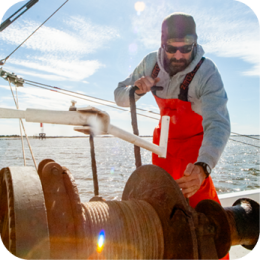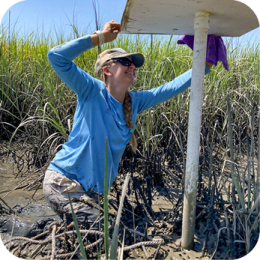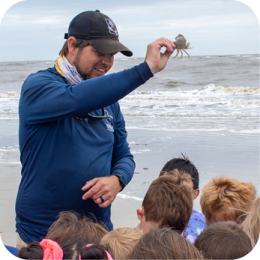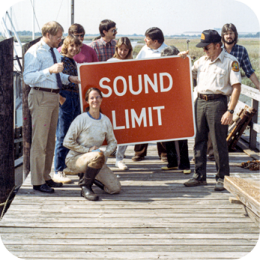
By TYLER JONES
Public Information Officer
Coastal Resources Division
The Georgia coastline, adorned with a necklace of barrier islands, is a dynamic tapestry woven by sand, wind, and water. An intricate system, known as the sand-sharing system, with its sand bars, beaches and dunes, is a marvel of natural engineering. It is constantly shifting and reshaping the islands to ensure their survival. Understanding this delicate dance between erosion and accretion is crucial, not only for the ecological health of the islands, but also for the communities that call them home.
The foundation of the sand-sharing system lies in the barrier islands themselves. Formed millennia ago by the relentless movement of sand and sediment, these islands act as the first line of defense for the mainland. They shield the coast from the fury of storms, dissipate wave energy, and provide critical habitat for a diverse range of flora and fauna. As Karl Burgess, CRD’s assistant director, explains, “Barrier beaches protect uplands, lagoons, estuaries, and salt marsh from the direct impacts from the ocean.”
The islands, from Tybee to Cumberland, are composed of sand originating from rivers like the Altamaha, which carry weathered rocks and minerals downstream. Upon reaching the coast, these sediments are caught in the grip of longshore currents, powerful currents that flow parallel to the shore. These currents, on the Georgia coast, driven by counter-clockwise eddies off the Gulf Stream, transport sand southward on Georgia’s coast.
The Continuous Flow of Sand
This continuous movement of sand is the essence of the sand-sharing system. In some areas, waves erode the shoreline, removing sand and transporting elsewhere. This process, known as erosion, can be exacerbated by factors like rising sea levels and intense storms. However, erosion is not solely destructive. As Burgess points out, “the sand eroded from one location becomes the building block for another.”
Offshore sandbars and shoals act as temporary reservoirs, storing sand until currents or storms redistribute it. Eventually, the eroded sand reaches beaches further down the coast, replenishing shorelines and nourishing dunes. This dynamic exchange ensures a constant flow of sand, maintaining the health and integrity of the entire system.
The Vital Role of Dunes
Sand dunes play a critical role in the sand-sharing system. These vegetated mounds of sand act as a natural barrier against storm surges and high tides. Beach winds blow dry sand landward, where it accumulates to form dunes. Dune vegetation, like sea oats with their extensive root systems, traps this sand, preventing it from being blown inland and stabilizing the dunes. Healthy dunes provide a crucial buffer zone, absorbing wave energy and protecting coastal communities and infrastructure from flooding and erosion.
Another important, but often misunderstood, component of dunes is the marsh wrack that helps form them.
“In Georgia, marsh wrack typically consists of decaying saltmarsh grasses that have drifted down rivers before washing ashore, especially after very high tides,” Burgess said. “It may be unsightly, but it’s extremely important.”
That’s because wrack is crucial to the formation of dunes by providing stabilization for windblown sand. The mixture of dead grass, sand, and moisture creates a suitable environment for the growth of plants like sea oats.
Threats to the Delicate Balance
Unfortunately, human activity can disrupt the delicate balance of the sand-sharing system. Coastal development, for instance, sometimes involves the construction of seawalls and revetments to protect beachfront property. While these structures may offer a sense of security, they disrupt the natural flow of sand. By preventing erosion at one point, they starve beaches down the coast of the sand they need to replenish themselves. This can lead to beach narrowing and increased vulnerability to storm surges.
The impacts of climate change pose another significant threat to Georgia’s barrier islands. Rising sea levels are causing increased erosion, inundating low-lying areas, and jeopardizing the future of the sand-sharing system. Additionally, more frequent and intense storms can accelerate erosion and damage dune systems.
Protecting a Vital System
Protecting this vital system requires a multi-pronged approach. Beach renourishment projects, which involve strategically adding sand to eroded beaches, can help maintain shorelines and dunes. Tybee Island, in partnership with DNR and the U.S. Army Corps of Engineers, for example, has seen success over the years with repeated renourishment projects.
The Sea Island Co.’s privately funded sand management program, dating back to the early 1980s, has also seen similar successful outcomes.
However, these projects are expensive and require ongoing maintenance. Conserving and restoring dune vegetation is critical for stabilizing dunes and promoting natural sand accumulation.
Georgia’s Shore Protection Act, enacted in 1979, regulates activities and structures in the jurisdictional beach and shore areas. Projects that require an SPA permit include nourishment, rock revetments, landscaping, and dune crossovers. The permitting process, which includes a committee with four citizens and the DNR commissioner, helps ensure that necessary projects within the jurisdiction are in the public’s interest.
A Look to the Future
The future of Georgia’s barrier islands is intricately linked to the health of the sand-sharing system. By understanding this dynamic process and implementing responsible coastal management practices, we can ensure that these vital ecosystems continue to thrive for generations to come. As Burgess notes, “Georgia’s Shore Protection Act highlights the balancing act between allowing development in the public interest, while maintaining a critical resource that both protects our communities, and provides a source of enjoyment to so many. ”
This combined perspective, incorporating the scientific understanding of the sand-sharing system and the practical applications of coastal management, paves the way for a sustainable future for Georgia’s treasured barrier islands.







